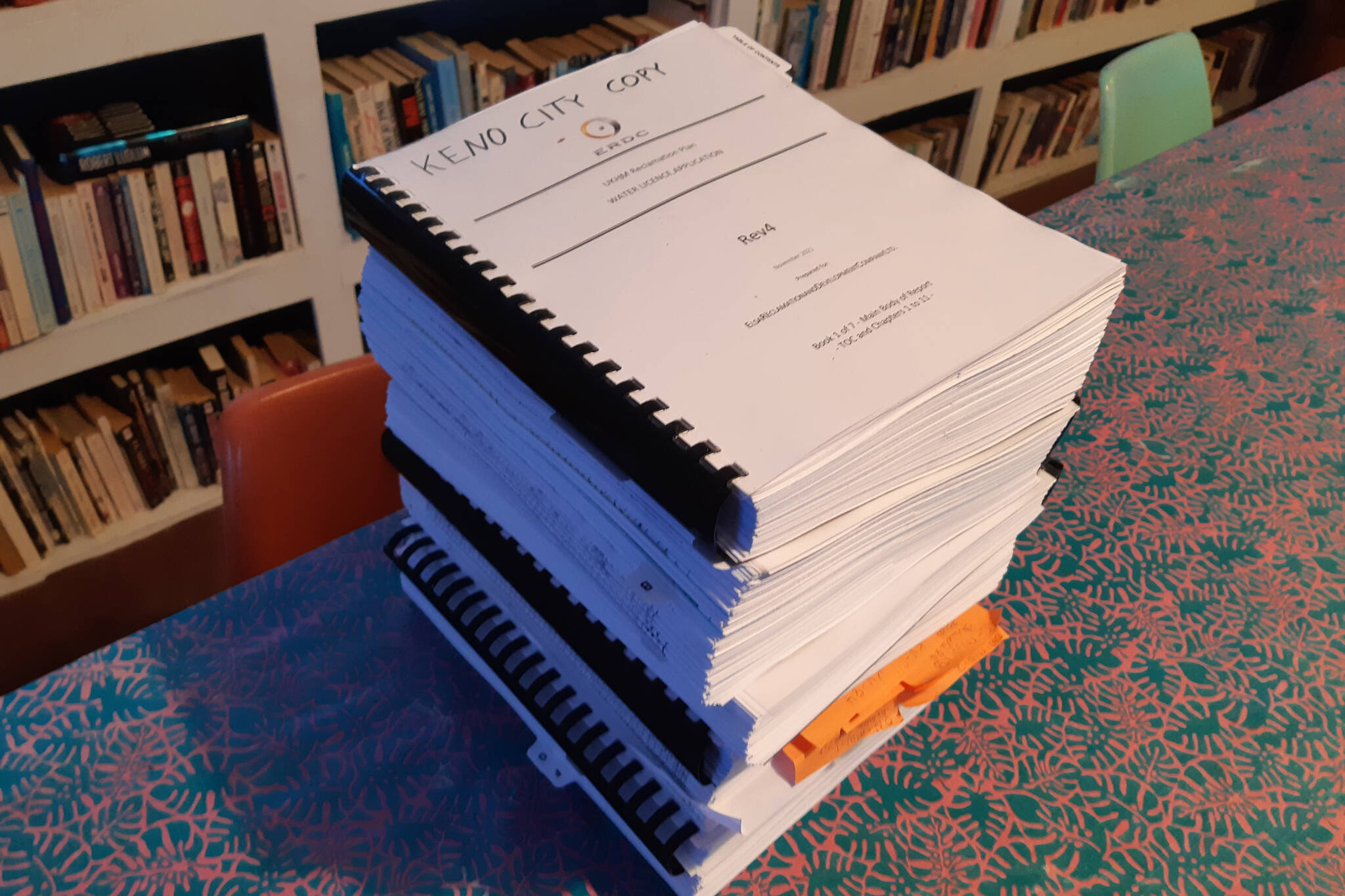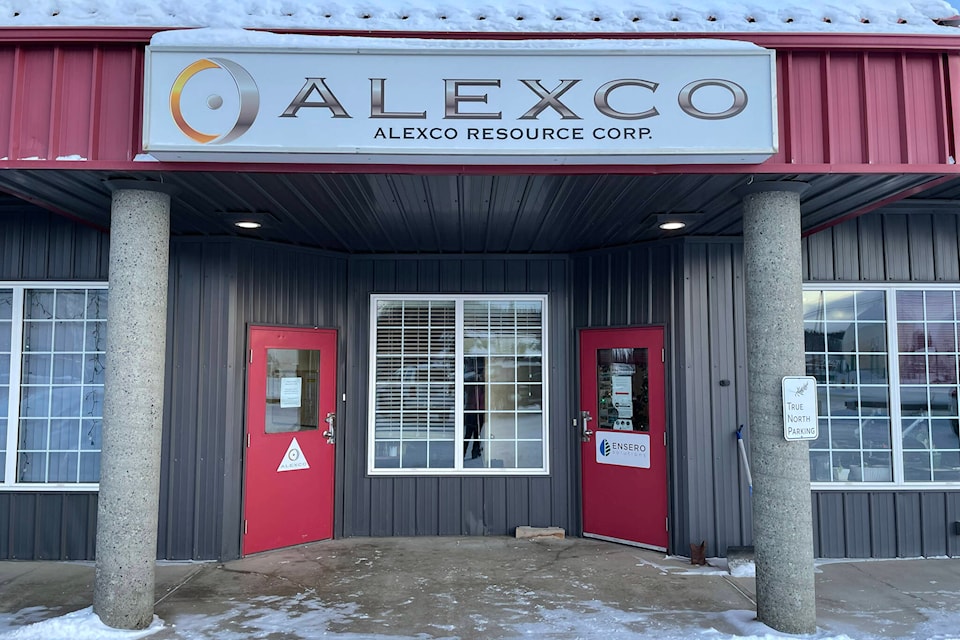The water license application for Yukon’s historic Keno Hill mining district, which has been in the works for fifteen years, and has cost the federal government $34 million dollars to develop, is up for public review.
The period for public comment will run for 3o days. The Yukon public is asked to review and provide comments on a stack of reports that measures 38 centimetres high. Public hearings will only take place if there is sufficient public interest.
Keno City residents received an advance copy for their library before Christmas, and have been briefed by officials of Elsa Reclamation and Development (ERDC) and the other half of Alexco’s corporate structure, Alexco Keno Hill Mining Corp. (AKHM).
Keno residents have been able to walk over to their tiny church that functions as a library, light a fire in the stove, read, and add bright orange stickies to different pages in the pile, but the Mayo library does not have a hard copy.
Everybody can find the application through the Yukon Water Board, searching QZ21-012 and then clicking onto any of 32 pdfs. There are another 15 links to relevant historical documents that are connected to the application.
To long-term followers of water board applications, the process is transparent and accessible, though a bit unwieldy and incredibly technical. For instance, water quality objectives are described in milligrams per litre of zinc, cadmium or arsenic. Measures are marked as dots on pages of graphs, rather than saying whether or not the water is drinkable, or if fish could survive without becoming contaminated.
The Yukon Water Board hired Hemmera, a large Australian consultancy with a Whitehorse office to help understand and assess the documents for the board members. Hemerra also works for several mining companies in the Yukon, and for a wide variety of YG departments. The public must decipher the documents on their own.
The reclamation plan has been in development for 15 years and involves a complex set of relationships between the federal government (financial responsibility and technical reviews), the Yukon government (inspection responsibility and new mines on site), the First Nation of Na-cho Nyak Dun (it’s their traditional territory and they have major advisory role), plus the two arms of Alexco Resources – ERDC and AKHM.
It will be up to ERDC and AKHM to sort historic sites from current and future operating sites. This license only applies to historic mine sites in the district.
Linda Broughton, vice-president of ERDC, says that in essence, they act as a contractor to the federal government. The production manager Wayne Zigarlick, vice-president operations, told the News in October that the two sides of the company share staff which creates efficiencies for both arms of the corporation.
READ MORE: Alexco working to remediate image at mine site near Keno City
This is likely the first of several operations that are clearly purchased and designed so that abandoned mines sites are remediated while the operator concurrently mines new properties in the area. The government’s thinking is that it makes abandoned mines more attractive to sell, and reduces remediation costs to government taxpayers.
In November 2021 Martin Guilbeault, with the federal Crown Indigenous Relations’ and Northern Affairs (CIRNAC) department of environment said the federal government has spent $30 million since 2001 for the care and maintenance of the Keno district and $34 million on the design of the reclamation plan.
He said that factors such as the size and breadth of the area (17,000 hectares), the challenges in characterizing the different adits and shafts, buildings, waste and tailing piles, as well as identifying heritage buildings and establishing baseline numbers to measure improvements against, all make the process costly in time and money.
Alexco is also running out the clock on their existing water license which expires August 8, 2022.
This water license application will replace the current water licence for “care and maintenance” and cover the next fifteen years of active reclamation, then another ten years of transition and then, 16 years later, operate to perpetuity. This application is deemed a renewal for the next 20 years.

Objectives on a slippery slope
When the mine was first acquired by ERDC in 2006, the promise to Yukon’s Supreme Court was for ultimate remediation. Now the plans call for treatment in perpetuity.
In 2008, Na-cho Nyak Dun (NND) members workshopped their key objectives for the closure which contained phrases like “protect land and animals” and “restore the environment.” They described areas for spawning, and where people and animals are free to wander safely, and to ensure there is drinkable water. They listed the animals and the fish by name, and identified the importance of protecting people’s health.
These objectives were collapsed and re-ordered by government and the company in the final setting of objectives so that “protect and restore” meant “prevent, minimize or mitigate adverse effects.” The feds and YG introduced other objectives: to minimize project-related liability and risks, and to minimize costs.
Seventh on NND’s list was that the project provides benefits to the NND and its citizens.
Thirteen years later, CIRNAC’s Guilbeault told the News that the main goals were to minimize the costs and maximize the socio-economic benefits.
Water treatment in the North has not changed much over the years due to lack of research data on more innovative methods. The main water treatment system will rely on catchments near leaky adits to collect water coming out of the old mines, then transporting it through heated pipes, to one (instead of five) settling pond where it will be treated, then periodically, the zinc-laden sludge will be scooped out.
It is a mammoth project, complicated by historic mining practices, permafrost, disappeared species, and the fact that the healing of the land will occur in the middle of an active mining district. Some adits will be plugged, waste rock buried, historic buildings stabilized and fencing will go up to keep curious people away and safe.
The Yukon Water Board currently has 38 applications on the traditional territory of Na-cho Nyak Dun before them. A public review period started on Victoria Gold’s amendment to their closure plan and water license just days before the Alexco public process was started. The review period ends Feb. 23 for ERDC/Alexco and Feb. 21 for Victoria Gold.
Contact Lawrie Crawford at lawrie.crawford@yukon-news.com
